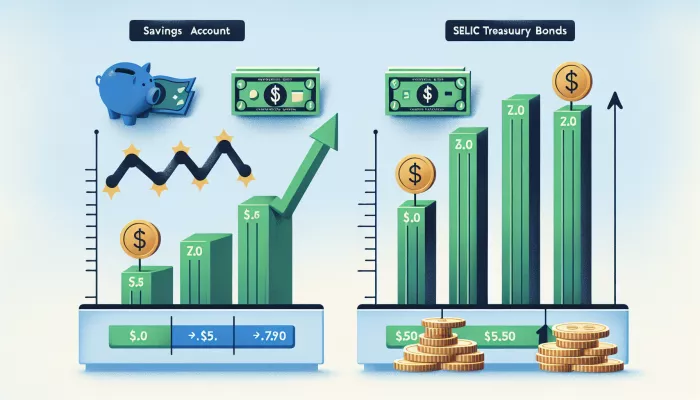

Savings vs. Treasury Selic. When deciding where to invest your money, it is essential to understand the characteristics of each investment option. These are two well-known and sought-after alternatives.
Although both are considered low-risk investments, there are a number of differences between them that may influence your choice.
The Tesouro Selic is a public bond, considered one of the safest investments on the market. Its profitability is linked to the Selic rate, which means it changes according to the country's economic policy.
The Tesouro Selic offers daily liquidity, meaning that it is possible to withdraw the money at any time, and the yield is calculated daily, which can be a differentiator for many investors.
Savings is the most popular type of investment in Brazil. Its main characteristics are simplicity and security.
Savings income is defined by the remuneration rule, which combines a fixed rate of 0.5% per month, when the Selic rate is higher than 8.5% per year, or 70% of the Selic rate, when it is equal to or lower than 8.5%.
The calculation is done monthly, and the money needs to be in the account on the anniversary date for it to earn interest.
The choice between Savings and Treasury Selic depends on each investor's profile, their financial planning and short, medium and long-term goals.
While Savings is a more traditional option, with ease of use and exemption from fees.
The Tesouro Selic can offer greater profitability, especially in periods of high Selic rates, in addition to offering daily liquidity.
Conclusion: When deciding between Savings and Treasury Selic, it is important to consider the characteristics of each investment, including security, yield, liquidity, and fees involved.
This understanding will help you make the choice that best suits your financial goals.
For more information, visit:
– Brazilian central bank
– Treasury Direct
Calculating the return on investments such as Savings and Treasury Selic is essential for planning your finances.
Fortunately, understanding these calculations is not as complicated as it seems. Let's simplify these processes.
Current rule: Savings yield depends on the Selic rate.
When is it above 8.5%, savings yield 0.5% per month plus the TR (Reference Rate). When the Selic is equal to or less than 8.5%, it yields 70% of Selic plus TR.
To calculate:
The Tesouro Selic follows the Selic rate, offering a daily return. Therefore, it is known for its liquidity and low risk.
To calculate the yield, the methodology involves:
Practical example: Assume an investment of R$1,000 in Tesouro Selic, with the Selic rate at 4.25% per year. Calculate the daily yield as follows: R$1,000 x (4.25%/100) / 252 = R$0.169 per day.
These calculations give you an initial view of what to expect from your investments in terms of returns.
However, it is important to remember to consider inflation, which can affect the purchasing power of your return over time.
Now that you have an idea of how to calculate the yield on Savings and Treasury Selic, you can better plan your investments.
Always review these calculations periodically, as rates and economic conditions change.
Useful links:
When looking for ways to make our money grow, it is essential to understand the different factors that influence return on investment.
These factors can help you make more informed choices and align your expectations with market reality. Let’s look at the main ones:
A interest rate is one of the main factors affecting investment returns.
When rates are high, fixed income investments, such as Savings and Treasury Selic, tend to offer more attractive returns.
However, this can also slow down the economy, affecting stock investments.
A inflation is the rate at which the value of money falls over time, directly affecting purchasing power.
Investments that offer a return lower than the rate of inflation effectively result in a loss of money.
Therefore, it is crucial to seek investments that promise returns above inflation to ensure real capital growth.
O market risk refers to changes in the price of investments due to changes in the economy or in specific industries. Equity securities, such as stocks, are particularly exposed to such risks, but they can offer significant returns to compensate.
The length of time you plan to hold your investment, or investment horizon, also plays a crucial role.
Higher-risk investments, such as stocks, may be better suited for longer-term horizons as they allow you to ride out market volatility.
Finally, the global economic conditions also have a big impact on investments.
Economic crises, geopolitical conflicts, and pandemics can negatively affect the market, while periods of economic growth can boost returns.
Understanding these factors and how they interact can help you make more informed investment choices.
Remember that financial education is a powerful tool in investment management.
For more information on how to invest wisely, consider visiting educational sites like Investor.gov or investment tools like Bloomberg.
Diversify your investments can reduce the overall risk of your portfolio.
Investing in different types of assets (stocks, bonds, real estate, etc.) can protect against significant losses, as not all sectors or markets move in the same direction at the same time.
Changes in government policies, such as investment taxes, subsidies, and regulations, can directly impact returns.
It is crucial to pay attention to the news and how government actions can influence different asset classes.